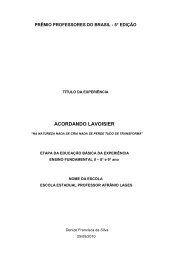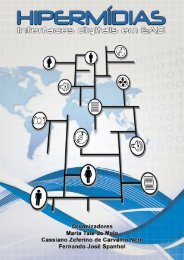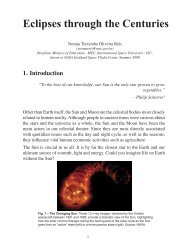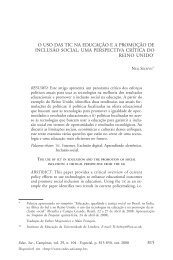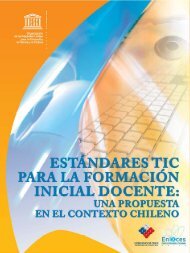BIO-CULTURAL COMMUNITY PROTOCOLS - Portal do Professor
BIO-CULTURAL COMMUNITY PROTOCOLS - Portal do Professor
BIO-CULTURAL COMMUNITY PROTOCOLS - Portal do Professor
Create successful ePaper yourself
Turn your PDF publications into a flip-book with our unique Google optimized e-Paper software.
PART II / CHAPTER 6<br />
• In-kind payments, such as the beehive-for-conservation<br />
payment transaction that Fundación Natura is making<br />
in Bolivia; 20<br />
and<br />
• Recognition of rights, such as increased land or access<br />
rights and increased participation in decision-making<br />
processes. 21<br />
Additional methods are also listed by UNEP, including a “pay<br />
per tree” scheme, forest protection or restoration schemes<br />
and payment through improved service delivery.<br />
There are many other options for PES schemes that could<br />
be adapted to the local needs of the involved provider<br />
communities. 22<br />
In order to identify the optimal form of PES scheme, there<br />
must be dialogue about the different options. This should<br />
include increasing the provider community’s understanding<br />
of the benefits of the different forms of PES available in<br />
order to strengthen its capacity to make effective decisions<br />
and increase its bargaining power in negotiations.<br />
4.4 High Transaction Costs of<br />
Community-based Negotiations<br />
In a study on forest ESS and the impact of payment schemes<br />
for poor communities living in or near the forest, the<br />
International Institute for Environment and Development<br />
(IIED) warns: …transaction costs are likely to be highest<br />
for small forest holders who lack basic organisational,<br />
forest management and marketing skills. Monitoring and<br />
certifying delivery of biodiversity management, for instance,<br />
will tend to be more expensive for a number of small plots<br />
than for larger landholdings. Where a minimum area is<br />
required to qualify for a biodiversity protection contract,<br />
additional costs are born by smallholders who must<br />
<strong>BIO</strong>-<strong>CULTURAL</strong> <strong>COMMUNITY</strong> <strong>PROTOCOLS</strong> IN THE<br />
CONTEXT OF PAYMENT FOR ECOSYSTEM SERVICES<br />
co-ordinate amongst themselves before negotiating<br />
with buyers. 23<br />
Furthermore, overcoming any of the abovementioned<br />
challenges that are a part of participatory<br />
engagement with communities will be time-consuming and<br />
expensive. Most potential ESS buyers will seek out negotiation<br />
partners with the lowest transaction costs, which tend<br />
to be larger lan<strong>do</strong>wners, minimizing the need for prolonged<br />
negotiations or pre-negotiations. This is a clear disadvantage<br />
for involving communities in PES schemes and <strong>do</strong>nor funding<br />
may be necessary to cover the high initial transaction<br />
and set-up costs.<br />
4.5 The Need for a Clear Definition<br />
of Property Rights<br />
While PES schemes are often set up privately and in the large<br />
majority of cases <strong>do</strong> not rely on a specific regulatory framework,<br />
it is important to remember that they also <strong>do</strong> not take place<br />
in a legal or political vacuum. For example, certain national<br />
fiscal policies or subsidies may run counter to the concepts<br />
of PES schemes and may prevent the introduction of<br />
alternative forms of land use in certain areas. Some countries<br />
such as Ecua<strong>do</strong>r and Costa Rica have recently revisited their<br />
forestry laws precisely to update such national fiscal policies<br />
and facilitate the success of PES schemes. 24<br />
Furthermore, clarity of property rights is central to the<br />
functioning of any PES scheme. 25<br />
In situations in which land<br />
ownership and tenure and access and use rights are ambiguous,<br />
it is unclear who is the provider of ESS and thus very difficult<br />
to create PES schemes. Particularly if PES schemes are to<br />
benefit small and local communities, it is of utmost importance<br />
to ensure that their rights to accessing the land are in<br />
place and clarified.<br />
20. http://www.naturabolivia.org/Informacion/Proy2.pdf<br />
21. Supra note 5.<br />
22. Furthermore, communities are likely to also experience certain secondary benefits from engaging in PES schemes. These include: the transfer of technical skills such as<br />
mapping, surveying, and new, alternative and sustainable forms of land use. It may also lead to economic empowerment of communities that are seen as providing a<br />
service rather than engaging in ‘practice as usual’, and they may also gain experience in engaging with outside business. In cases in which communities already actively<br />
contribute to the maintenance of the local environment through sustainable harvesting practices, they should be rewarded for such activities as an incentive to maintain<br />
the status quo in the future. Indeed, as case studies in Costa Rica have shown, communities above all derive benefits from the secondary effects of PES schemes.<br />
This includes their engagement with the supporting organizations, such as training to develop forestry activities, strengthened organization and improved external<br />
linkages. When local landscape is transformed, it may also generate value for local communities through its impact on other ESS on which they depend, such as water<br />
quality and quantity. In turn, this may generate increased local tourism and scientific opportunities, which would also benefit them in the medium-term.<br />
See: “Payment for Environmental Services and Rural Communities: Lessons from the Americas” Herman Rosa, Susan Kandel, Leopol<strong>do</strong> Dimas and Ernesto Mendez,<br />
PRISMA (Programa Salva<strong>do</strong>reño de Investigación sobre Desarrollo y Medio Ambiente)<br />
23. “Silver bullet or fools’ gold? A global review of markets for forest environmental services and their impact on the poor” Natasha Landell-Mills and<br />
Ina T. Porras March 2002, IIED. Page 62.<br />
24. See for example: Pagiola, S. 2002. “Paying for Water Services in Central America: Learning from Costa Rica,” and Echevarría, M. 2002. “Financing Watershed Conservation:<br />
The Fonag Water Fund in Quito, Ecua<strong>do</strong>r,” both in Pagiola, S. et al. “Selling Forest Environmental Services. Market-based Mechanisms for Conservation and Development.”<br />
Lon<strong>do</strong>n: Earthscan Publications Ltd (2002).<br />
25. Supra note 11.<br />
62





